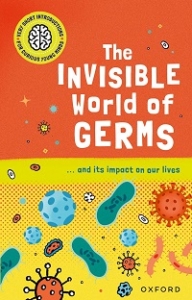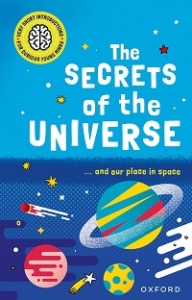Very Short Introductions for Curious Young Minds
Samantha Armstrong, Senior Publisher, Oxford Children’s Books, introduces a series designed to enrich children’s lives and vocabularies.
In a recent magazine article I discovered a xenobot, a wobbegong, and a new phrase for travel, ‘air mobility’. Whilst driving, I heard the word ‘axiomatically’ on the radio and repeated it until I could safely look up its meaning. Words are fascinating, not least because there are so many that we’ve not heard before, and while that might not happen every day to us as adults, it’s a reminder that we all have our own word gap.
For children in UK schools, as discovered in the first Oxford Language Report Why Closing the Word Gap Matters.(2018), a much more significant word gap exists, and it not only holds back children’s learning but limits their enjoyment of school and their success beyond. On average, secondary school teachers who took part in the survey reported that 43% of Year 7 pupils have a limited vocabulary to the extent that it affects their learning and 95% of secondary school teachers believe a lack of time spent reading for pleasure is a root cause of the word gap. More recently, the follow up report,.Bridging the Word Gap at Transition.(2020), found that 87% agree that increasing academic requirements as pupils move from primary to secondary education, highlight pupils’ struggles with vocabulary and that pupils may have read less widely for pleasure during lockdown.
 Language gives children the capacity to enjoy new subjects and releases their potential to learn and grow. It also underpins progress at school and in life. If we know that young people need exposure to different types of language, perhaps from discovering what a xenobot is (a synthetic lifeform) and seeing a picture of a wobbegong (a type of carpet shark), to the abstract language of exam question rubric such as ‘analyze’ or ‘discuss’, the question for us is how best to support children with both these types of language, and at an age-appropriate level. Reading for pleasure means different things to different children. For some, adventures and characters in fiction are the way in. And for others they discover the wonder of inventions and experiments, of scientists and spaceships, of real-life individuals who lead us to a better understanding of the world, through non-fiction. Sometimes non-fiction feels like fiction when the information is fascinating and is written in a way that pulls the reader in, making them eager to find the next piece of the jigsaw. When we are reading about a subject we are interested in, we all have an appetite for new words. It is this magical link between subjects that children want to explore and learning that we aimed to capture with the Very Short Introductions for Curious Young Minds series.
Language gives children the capacity to enjoy new subjects and releases their potential to learn and grow. It also underpins progress at school and in life. If we know that young people need exposure to different types of language, perhaps from discovering what a xenobot is (a synthetic lifeform) and seeing a picture of a wobbegong (a type of carpet shark), to the abstract language of exam question rubric such as ‘analyze’ or ‘discuss’, the question for us is how best to support children with both these types of language, and at an age-appropriate level. Reading for pleasure means different things to different children. For some, adventures and characters in fiction are the way in. And for others they discover the wonder of inventions and experiments, of scientists and spaceships, of real-life individuals who lead us to a better understanding of the world, through non-fiction. Sometimes non-fiction feels like fiction when the information is fascinating and is written in a way that pulls the reader in, making them eager to find the next piece of the jigsaw. When we are reading about a subject we are interested in, we all have an appetite for new words. It is this magical link between subjects that children want to explore and learning that we aimed to capture with the Very Short Introductions for Curious Young Minds series.
Standing on the shoulders of the OUP series, Very Short Introductions which has over 700 titles written for undergraduates and general adult readers, this new series is designed to inspire young people aged 9–12 years to understand the who, why, how (and what next) of a diverse range of big topics – and to get confident with the vocabulary used in them. Four titles are to be published every year, each one as a small paperback (perfect for reading under the duvet by the light of a torch app). Importantly the titles are designed to foster a passion for complex subjects – ones which are tailored to support GCSE preparation – and with bright, often humorous illustrations and comic strips, they will give readers the chance to understand challenging concepts and vocabulary from across humanities, technology, social sciences, arts, earth sciences, computing, physics, engineering, and more.
Alongside the curriculum, analysis of the Oxford Children’s Corpus, a unique database of writing for and by children, helps tailor titles to the  interests of young readers. The Corpus contains writing for children, as well as over a million stories written by children over the last few years for Radio 2’s 500 Words children’s writing competition. As part of ongoing language and lexical research, the Children’s Language department analyzes the Corpus using a team of lexicographers, editors, teachers, academics, and computational linguists who research the language and vocabulary and track how it changes and evolves. Each year the findings show how children’s writing reflects not only perennial interests such as football and space, but the changing national and global preoccupations and events of the year. The young writers, especially in the 9–13-year age bracket, explore the same stories that are in the news – the global concerns, tragedies, and political events – with the writers becoming problem solvers and solution finders. This topicality is reflected in the choice of the Oxford Children’s Word of the Year – from refugee to Brexit and plastic, to Coronavirus in 2020 and anxiety in 2021. Fitting, then, that the first of the Very Short Introductions for Curious Young Minds tap into these concerns and interests – The Invisible World of Germs and how they have impact on our lives and The Secrets of the Universe and our place in space.
interests of young readers. The Corpus contains writing for children, as well as over a million stories written by children over the last few years for Radio 2’s 500 Words children’s writing competition. As part of ongoing language and lexical research, the Children’s Language department analyzes the Corpus using a team of lexicographers, editors, teachers, academics, and computational linguists who research the language and vocabulary and track how it changes and evolves. Each year the findings show how children’s writing reflects not only perennial interests such as football and space, but the changing national and global preoccupations and events of the year. The young writers, especially in the 9–13-year age bracket, explore the same stories that are in the news – the global concerns, tragedies, and political events – with the writers becoming problem solvers and solution finders. This topicality is reflected in the choice of the Oxford Children’s Word of the Year – from refugee to Brexit and plastic, to Coronavirus in 2020 and anxiety in 2021. Fitting, then, that the first of the Very Short Introductions for Curious Young Minds tap into these concerns and interests – The Invisible World of Germs and how they have impact on our lives and The Secrets of the Universe and our place in space.
While children entering the 500 Words competition may have been encouraged to take part by schools, the stories they submitted were written with the aim of winning the competition rather than as part of marked assessment, and this allows us to track the words and language that children choose to use themselves when they write creatively. We see that some young writers are fearless in their choice of words. They are happy to use words such as parliamentary and chameleon and weave them in amongst vocabulary such as dinosaur names (e.g. ‘velociraptor’) or words like ‘intergalactic’ or ‘holographic’. Taking the same approach, the authors of our Very Short Introductions for Curious Young Minds, themselves passionate about their subjects and with the support of academic subject consultants, sprinkle technical terms and explanations into the books. It is inevitable that for example, when finding out how gravity works in The Secrets of the Universe, there is some ambitious vocabulary to encounter – phrases such as quadruple quasars and deep depressions; in Germs that microbes, protists, genomics, and zoonosis will come up; and in Artificial Intelligence readers will navigate terms such as deepfake, effectors, and algorithms. To encourage readers to ‘Speak like a Scientist’, or like an expert in the field, the terminology they need is contained in a speech bubble, as though chipping in with a short clear explanation of the trickier terms. Our hope is that readers feel empowered to use these words with confidence both in their writing and when talking about the subject to others. Expect to discover some new terms because we all know how hard it is to keep it in when you know some important stuff. The Corpus has also shown us that building this confidence with vocabulary releases creativity and develops the ability to play with root forms, prefixes, and suffixes to make up new words. For example, one Children’s Corpus story written by a 13-year-old features the term ‘cyberocracy’ – used to describe a political system which governed the earth in a story in which a technophobe granny complained about not getting a vote in the new world which was run by robots.
The skills needed to read and process sometimes challenging non-fiction content are valuable and transferable. Critical thinking and curiosity are required across all secondary school subjects and getting an insight into how our knowledge of the world is built encourages an engagement with learning. The Very Short Introductions style is engaging, with friendly reminders and asides, and teasers acting almost like clickbait to tempt the reader to the next chapter. Along the way we meet the key contributors to the field – including historically underrepresented characters such as Williamina Fleming, Annie Jump Cannon, Antonia Maury, and Florence Cushman who collectively devised a system using spectra to classify stars in the Universe which is still used today. These books require some concentration but bring with it the reward of understanding that sometimes we must be prepared to get things wrong and to have a go to learn and grow. The ambition is that young people apply this to their own learning journey and take up their roles as inventors, scientists, musicians, or activists.
The topics are endless, so this series has potential to grow exponentially. Twelve titles are already planned, and the hope is that young readers will develop their non-fiction reading skills, build their confidence with unfamiliar vocabulary, move onto the next title in the series, and collect a set. Such a set would enrich children’s lives by inspiring a lifelong love of reading, writing, and language, boosting their immunity against the inhibiting effects of the word gap, and help to create confident writers and communicators.
The Very Short Introductions for Curious Young Minds: The Invisible World of Germs (978-0-19-277923-6) and The Very Short Introductions for Curious Young Minds: The Secrets of the Universe (978-0-19-277921-2) are published by Oxford, £7.99 pbk.
Samantha Armstrong is Senior Publisher, Oxford Children’s Books.



